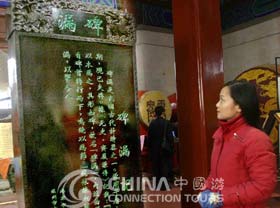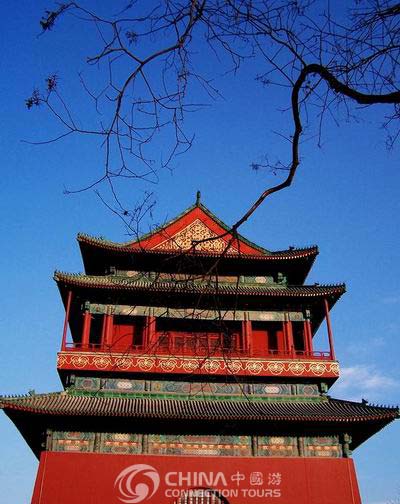
 The Drum Tower was built to beat the drum to mark the hour and time in the old days, and now it is standing nearby the Tian'anmen Square as a historical attraction. The Drum Tower was built in 1272 during the reign of Kublai Khan, at which time it stood at the very heart of the Yuan capital Dadu. In 1420, under the Ming Emperor Yongle, the building was reconstructed to the east of the original site and in 1800 under the Qing Emperor Jiaqing, large-scale renovations were carried out. Drum tower is a two-story building and the structure of Drum Tower was made of wood with a height of 47 meters. The first story of the Drum Tower is a solid square terrace four meters high, 55.6 meters long and 30 meters wide. The front and rear of the terrace are pierced with three arched openings and the two sides with one opening each. The broad, squat multi-eaves wooden structure built atop the terrace is impressive with its red wall and yellow glazed roof. In ancient times the upper story of the building housed 24 drums, of which only one survives. Its head is made of an entire ox hide and is 1.5 meters in diameter. A sword score on the side of the drum is a souvenir of the Eight-Power Allied Forces' invasion of Beijing in 1900. The drum is beaten four times a day, for 15 minutes at a time.
The Drum Tower was built to beat the drum to mark the hour and time in the old days, and now it is standing nearby the Tian'anmen Square as a historical attraction. The Drum Tower was built in 1272 during the reign of Kublai Khan, at which time it stood at the very heart of the Yuan capital Dadu. In 1420, under the Ming Emperor Yongle, the building was reconstructed to the east of the original site and in 1800 under the Qing Emperor Jiaqing, large-scale renovations were carried out. Drum tower is a two-story building and the structure of Drum Tower was made of wood with a height of 47 meters. The first story of the Drum Tower is a solid square terrace four meters high, 55.6 meters long and 30 meters wide. The front and rear of the terrace are pierced with three arched openings and the two sides with one opening each. The broad, squat multi-eaves wooden structure built atop the terrace is impressive with its red wall and yellow glazed roof. In ancient times the upper story of the building housed 24 drums, of which only one survives. Its head is made of an entire ox hide and is 1.5 meters in diameter. A sword score on the side of the drum is a souvenir of the Eight-Power Allied Forces' invasion of Beijing in 1900. The drum is beaten four times a day, for 15 minutes at a time.

Drum towers was time telling center during the Yuan, Ming and Qing Dynasties (1271-1911). At seven o'clock in the evening, the drum was beaten followed by the bell to inform people it was time to go to sleep. According to legend, an official named Deng tried unsuccessfully for over a year to cast the bell. On the eve of the final casting, his daughter, fearing that further delays and loss of working time would bring blame on her father, decided to sacrifice her life in order to move the gods to bring about a perfect casting, and threw her into the molten bronze. Her panic-stricken father could only recover a single embroidered slipper from the flames. The casting was a success and the emperor, moved by the young girl's spirit of sacrifice, named her the "Goddess of the Golden Furnace" and built a temple in her honor near the foundry. By the ordinary people she was remembered as the "Goddess Who Cast the Bell." After the bell was installed, the chimes could be heard clearly and resonantly all across the city. But on stormy evenings, the bell would emit a desolate moaning sound similar to the word xie, which means "shoe" in Chinese. Recalling the old legend, mothers would comfort their children with: "Go to sleep! The Bell Tower is tolling. The Goddess Who Cast the Bell wants her embroidered slipper back."
The four bronze clepsydras, which once functioned in the Drum Tower, were reputed to date from the Song Dynasty. Set between these four devices was a large bronze gong, which through a series of mechanical devices was linked to the water clocks and sounded each quarter of an hour. When the system of telling time with incense coils, which burned for hours were introduced, the clepsydras fell into disuse.

